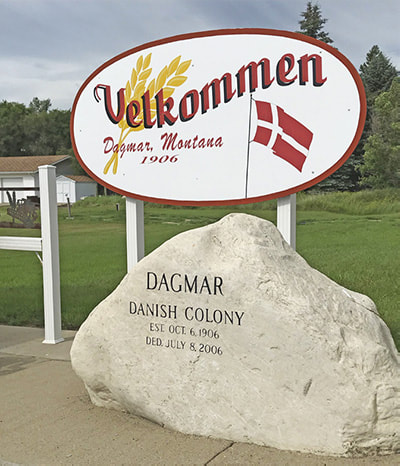 By ROBERT S. HANSEN I had thought I would begin this essay with a quoted verse from a gospel hymn just as my brother Erik started his story of Danevang, Texas. I soon decided that gospel music fits well in a story of Texas, but not so much in a story of Montana. Therefore, I will begin with a John Denver tune of a young Montana mother imploring Montana to give her newborn a home. The verse goes on: 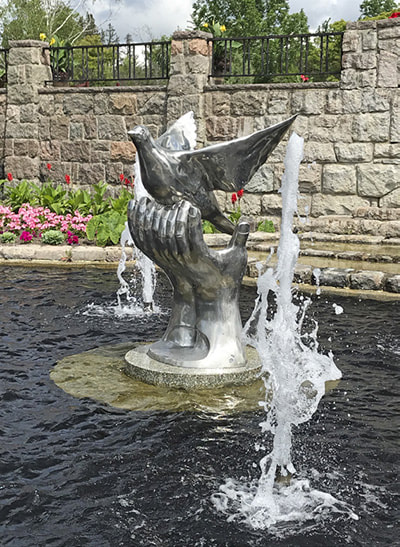 “Give him a fire in his heart, Give him a light in his eyes, Give him the wild wind for a brother And the wild Montana skies.” I also realize this account of a trip to Dagmar, MT actually began at Danebod Family Camp in Tyler, MN where Cathy and I visited our granddaughter from Texas during her first-time attending camp. We drove northwest from Tyler and hit US highway 75 where it passes Diamond Lake Lutheran Church, another AELC church I‘m sure many readers are familiar with. We continued north into the flatness of the Red River Valley. The main crops now changed from corn and beans to sugar beets, wheat and potatoes. 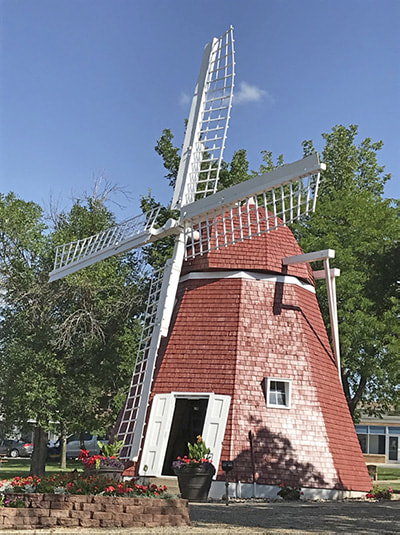 For many years I have studied maps as a hobby and saw this possibility of driving as a “shunpiker” (one who shuns driving the turnpikes and freeways) all the way across North Dakota on a series of state highways and county roads, some of which are gravel-surfaced, and running just two to seven or eight miles south of the Canadian border. The idea of driving across North Dakota inspired the trip to Dagmar because when you make that state crossing and eventually come out at the Montana border, you are just a few miles from Dagmar. We could not help, then, making the visit there the main purpose of the trip. That and my memories of attending Y.P.S. camp at Luck, WI two summers during the early 1960’s. I was impressed that the Dagmar congregations always sent one or two carloads of kids to camp at West Denmark. Just getting there was no small endeavor. 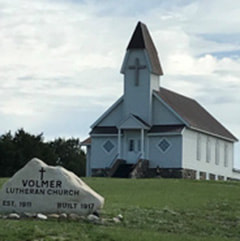 Volmer Lutheran Church Volmer Lutheran Church Heading west from the far northwest corner of Minnesota, traveling roughly 1/3 of the way across North Dakota, one comes upon the International Peace Garden. The garden was created in 1932 as a formal garden on the U.S. and Canada border where peace between nations could be celebrated. The conservatory and gardens boast more than 80,000 different species of annuals and flowering perennials highlighted throughout the garden which serves as an informal entrance to the Turtle Mountains. This region of the state, was to me, the biggest surprise of the entire trip. It comprises an area roughly 20 miles north to south by 40 miles east to west and rises to an elevation of 2,000 feet above sea level and about 1,000 feet above the prairie floor. I had never considered that we would find two downhill ski resorts in North Dakota drawing skiers from Fargo and Bismarck, ND to Winnipeg, Manitoba. 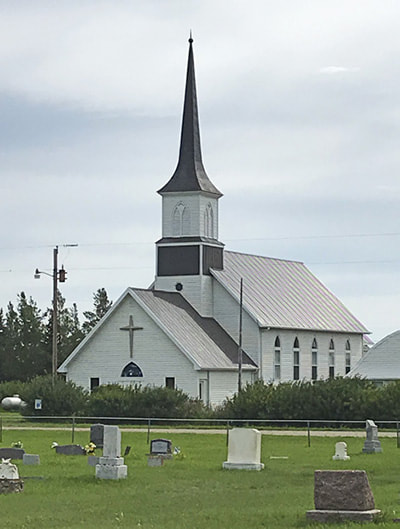 Nathaneal Lutheran Church Nathaneal Lutheran Church Descending quickly back to the flat prairie one re-enters the vast farm country settled mostly by Norwegian immigrants. The connection is easily made by the always visible steeples of many now abandoned Lutheran churches. One village named simply Vang, ND was home to one of these churches. As we know from our own communities of Solvang, CA and Danevang, TX, the word Vang means field in Danish and Norwegian. But in this case, it’s a bit of a misnomer. It should have been plural because as far as the eye can see were hundreds of fields of canola, flax and wheat. 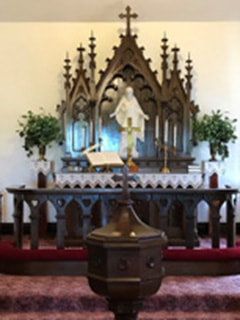 Altar in Volmer Lutheran Church Altar in Volmer Lutheran Church We took one short diversion to the south about 20 miles from our Canadian border route to visit the town of Kenmare, ND. Kenmare is located 80-90 miles east of Dagmar, MT and was home to a considerable number of Danish immigrants from the ULC synod. The town was originally named Lignite which is a type of coal that was discovered and mined from underground mines. The coal was shipped on barges down Des Lacs Lake to the Missouri River and points east. Making the connection to the present-day Bakken shale oil field is easy as we know that coal is simply crude oil in solid form. Another interesting feature of Kenmare has the business district designed around a town square, a feature not common in the Midwest but more prolific in southern and western towns. But maybe one must consider this an old west town as the founder of the community, Augustines Rouses, served as postmaster and later was appointed sheriff. On his second day in that capacity, he was killed in a gun fight. 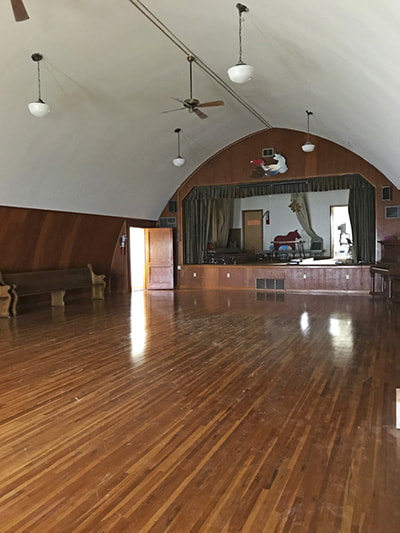 Nathaneal Lutheran Gym Hall Nathaneal Lutheran Gym Hall In the center of the square stands the Danish Mill. This mill was originally built in 1902 by a Danish homesteader about 11 miles north of town. It was used by area farmers for grinding grain into livestock feed and flour. It could produce about 200 sacks of flour a day. In 1959 the mill was disassembled and moved to the village square and given a facelift in 1996. On January 13, 2019 the Danish Mill caught fire just after 6:00 AM. The fire, ruled arson, started inside and caused considerable damage to both interior and exterior. The fire struck a nerve in the community and through a donation fund was completely restored by June 2019, shortly before our visit. 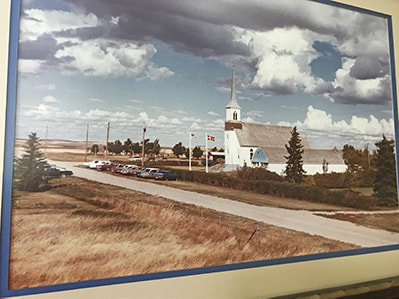 Returning to our border route, we passed through the village of Flaxton, ND approximately 75 miles from the Montana border. This town is worth mentioning because the ULC Danish Church there was served by Pastor Henrik Plambeck in the early years of the 20th century. Plambeck, a young pastor just out of Grand View seminary first saw the need for founding a new Danish Evangelical Lutheran settlement farther west. Circumstances prevented him from carrying out his plan but his good friend, E. F. Madsen was very inspired by his idea and went forward with the work and made the colony at Dagmar a reality according to “Century of Memories, Dagmar, Montana 1906-2006.” There was also much help from the “Dansk Folkesamfund” (Danish People’s Society) and the publication “Dannevirke.” So now we have crossed North Dakota and reached our destination of Dagmar, MT. One might ask the next logical question: What did you find there? First, I’m glad to report that the village itself is alive and hanging on by a thread. There is a newly remodeled and reopened C. J’s Country Store which stocks a few groceries and cooking staples. It also serves burgers and short order meals in a pleasantly decorated and clean restaurant. I asked the owner if she was a Dagmar native? “No, we moved here from Oregon. My husband got a job and works in Plentywood and we wanted to live in the country, so we ended up near Dagmar. We thought this store, which was closed when we came here, might be a business opportunity and we could provide some needed grocery items to area residents.” Next door stands a modern concrete block constructed Post Office which has operated since 1907. There are also a couple of trucking company garages, a cellular phone tower and maybe up to a dozen residences, some of which were obviously unlived in. The former Hiawatha Elementary School is still standing. It had been remodeled into a family home but now stands empty. However, it is still recognizable with the bell tower, playground swing, slide and basketball/tennis court. Most area children attended grade school there and transferred to nearby Antelope for their high school education. I am most pleased to report that what does still thrive are the two beautiful churches, Nathaneal Lutheran established in 1907, located about two miles west of town, and Volmer Lutheran established in 1911 and located about eight to nine miles southeast of town. In both cases, the church buildings were built several years after the congregations were established. When planning this trip, I had thought the reason there were two churches just a few miles apart must have had something to do with the split between the Grundtvigian-leaning Danes and the Inner Mission-leaning Danes. I was happy to hear from a former Dagmar resident that was not the case. Rather, it had to do with the large number of Danes from already established communities further east that resettled at Dagmar. They were drawn by the promise of homesteading 160 acres of good farming land. Both congregations were Grundtvigian and were served as a two-point parish by one minister. They both feature beautiful sanctuary interiors with pews and altar furnishings carved by Jess Smidt of Luck, WI and Thorvaldsen’s Christ statues as the altar focal point. Nathaneal Lutheran also built an attached gym hall as did many other Danish congregations. The Viking Gym Team performed gymnastic exhibitions at Dagmar and surrounding communities. Their 1912 flag hangs in Nathaneal Church and is inscribed with their Danish motto which translates as “A healthy soul in a healthy body.” How Grundtvigian is that? Both church basements served as parish halls and featured well equipped kitchens and ample space for socializing and Sunday school classrooms. The cemeteries at both churches are filled with graves and tombstones bearing very familiar names that could have been in any Danish community. The inscribed dates of birth and death attest to how difficult life for the pioneers must have been in that era. Many people were born in Denmark or other places in the U.S. and perished at a young age from a myriad of causes within a few years of arriving at Dagmar. As was common everywhere in that time period, there were many graves of children. In conclusion, I would quote E.F. Madsen in his 1906 appeal for settlers and his description of the reason for founding a Danish colony here: “The colony is planned for Danish young people and those Danes with small means who cannot carry large debts, but who would like to get out of the claws of the employers and away from the city‚‘s clamor and discord. Therefore, we can say about this colony ‘the first in our history where land is distributed free’ as we say about Queen Dagmar: “She came with burden, She came with peace, She came, the small farmer to comfort.” Photos by Cathy Mahowald [email protected]
1 Comment
Virginia Windschitl
2/8/2020 12:01:15 pm
Was interested to read about Flaxton N.D. because my Danish grandparents homesteaded there from 1900-1910.
Reply
Leave a Reply. |
Editor InformationBridget Lois Jensen Archives
March 2023
|
Subscribe | Gift |
Submit an Article |
Contact |
© COPYRIGHT 2019 CHURCH AND LIFE.
|
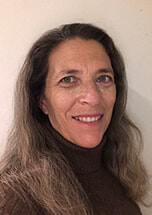
 RSS Feed
RSS Feed